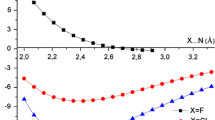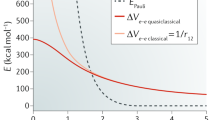Abstract
We disclose the common trends for relationships between the binding energy and the local electronic properties at the bond critical points of electron density for the halogen, chalcogen, and pnictogen bonds in molecular complexes. Variations in the sorting principles for noncovalent bonds in which the electrophilic site delivered by the P, As, S, Se, Cl, Br atoms are studied. Electronic kinetic and potential energy densities give regularly changing parameters in the single-factor models «binding energy versus local electronic property» only if a sort of electrophilic site provider is fixed. In contrast, the electrostatic potential and the potential acting on an electron in a molecule lead to the common trends only if the nucleophilic molecule is fixed. The behavior of parameters in the single-factor models was also studied under the different sorting principles of noncovalent bonds in samples.











Similar content being viewed by others
References
Bader RFW (1990) Atoms in molecules. A quantum theory. Oxford University Press, New York
Bader RFW, Essen H (1984) The characterization of atomic interactions. J Chem Phys 80:1943–1960
Cremer D, Kraka E (1984) A description of the chemical bond in terms of local properties of electron density and energy. Croat Chem Acta 57:1259–1281
Cioslowski J, Mixon ST (1991) Covalent bond orders in the topological theory of atoms in molecules. J Am Chem Soc 113:4142–4145
Tsirelson VG, Bartashevich EV, Stash AI, Potemkin VA (2007) Determination of covalent bond orders and atomic valence indices using topological features of the experimental electron density. Acta Crystallogr 63B:142–150
O’Brien SE, Popelier PLA (1999) Quantum molecular similarity. Part 2: the relation between properties in BCP space and bond length. Can J Chem 77:28–36
O’Brien SE, Popelier PLA (2001) Quantum molecular similarity. 3. QTMS descriptors. J Chem Inform Comput Sci 41:764–775
Popelier PLA (2016) In: Mingos M (ed) The chemical bond—100 years old and getting stronger. Springer, Cham
Matta CF (2014) Modeling biophysical and biological properties from the characteristics of the molecular electron density, electron localization and delocalization matrices, and the electrostatic potential. J Comput Chem 35:1165–1198
Boyd RJ, Choi SC (1986) Hydrogen bonding between nitriles and hydrogen halides and the topological properties of molecular charge distributions. Chem Phys Lett 129:62–65
Spackman MA (1986) A simple quantitative model of hydrogen bonding. J Chem Phys 85:6587–6600
Espinosa E, Lecomte ME (1998) C Hydrogen bond strengths revealed by topological analyses of experimentally observed electron densities. Chem Phys Lett 285:170–173
Mata I, Molins E, Alkorta I, Espinosa E (2009) Effect of an external electric field on the dissociation energy and the electron density properties: the case of the hydrogen bonded dimer HF···HF. J Chem Phys 130:044104
Mata I, Alkorta I, Espinosa E, Molins E (2011) Relationships between interaction energy, intermolecular distance and electron density properties in hydrogen bonded complexes under external electric fields. Chem Phys Lett 507:185–189
Espinosa E, Alkorta I, Elguero J, Molins E (2002) From weak to strong interactions: a comprehensive analysis of the topological and energetic properties of the electron density distribution involving X-HF–Y systems. J Chem Phys 117:5529–5542
Parthasarathi R, Subramanian V, Sathyamurthy N (2006) hydrogen bonding without borders: an atoms-in-molecules perspective. J Phys Chem A 110:3349–3351
Vener MV, Egorova AN, Churakov AV, Tsirelson VG (2012) Intermolecular hydrogen bond energies in crystals evaluated using electron density properties: DFT computations with periodic boundary conditions. J Comput Chem 33:2303–2309
Levina EO, Chernyshov IY, Voronin AP, Alekseiko LN, Stash AI, Vener MV (2019) Solving the enigma of weak fluorine contacts in the solid state: a periodic DFT study of fluorinated organic crystals. RSC Adv 9:12520–12537
Bushmarinov IS, Lyssenko KA, Antipin MY (2009) Atomic energy in the ‘Atoms in Molecules’ theory and its use for solving chemical problems. Russ Chem Rev 78:283–302
Lyssenko KA (2012) Analysis of supramolecular architectures: beyond molecular packing diagrams. Mendeleev Commun 22:1–7
Ivanov DM, Novikov AS, Ananyev IV, Kirina YV, Kukushkin VY (2016) Halogen bonding between metal centers and halocarbons. Chem Commun 52:5565–5568
Bartashevich EV, Tsirelson VG (2014) Interplay between non-covalent interactions in complexes and crystals with halogen bonds. Russ Chem Rev 83:1181–1203
Munchi P, Guru Row TN (2005) Charge density based classification of intermolecular interactions in molecular crystals. CrystEngComm 7:608–611
Spackman MA (2015) How reliable are intermolecular interaction energies estimated from topological analysis of experimental electron densities? Cryst Growth Des 15:5624–5628
Mata I, Alkorta I, Molins E, Espinosa E (2010) Universal features of the electron density distribution in hydrogen-bonding regions: a comprehensive study involving H···X (X = H, C, N, O, F, S, Cl, π) interactions. Chem Eur J 16:2442–2452
Ananyev IV, Karnoukhov VA, Dmitrienko AO, Lyssenko KA (2017) Toward a rigorous definition of a strength of any interaction between bader’s atomic basins. J Phys Chem A 121:4517–4522
Romanova A, Lyssenko K, Ananyev I (2018) Estimations of energy of noncovalent bonding from integrals over interatomic zero-flux surfaces: correlation trends and beyond. J Comput Chem 39:1607–1616
Bartashevich EV, Troitskaya EA, Martin Pendas A, Tsirelson VG (2015) Understanding the bifurcated halogen bonding N···Hal···N in bidentate diazaheterocyclic compounds. Comput Theor Chem 1053:229–237
Khrenova MG, Nemukhin AV, Tsirelson VG (2019) Origin of the π-stacking induced shifts in absorption spectral bands of the green fluorescent protein chromophore. Chem Phys 522:32–38
Desiraju GR, Ho PS, Kloo L, Legon AC, Marquardt R, Metrangolo P, Politzer P, Resnati G, Rissanen K (2013) Definition of the halogen bond (IUPAC Recommendations 2013). Pure Appl Chem 85:1711–1713
Kuznetsov ML (2019) Relationships between interaction energy and electron density properties for homo halogen bonds of the (A)nY–X···X–Z(B)m. Type (X = Cl, Br, I). Molecules 24:2733
Kuznetsov ML (2018) Can halogen bond energy be reliably estimated from electron density properties at bond critical point? The case of the (A)nZ Y···X − (X, Y = F, Cl, Br) interactions. Int J Quantum Chem 119:e25869
Terraneo G, Resnati G (2017) Bonding matters. Cryst Growth Des 17:1439–1440
Legon AC (2017) Tetrel, pnictogen and chalcogen bonds identified in the gas phase before they had names: a systematic look at non-covalent interactions. Phys Chem Chem Phys 19:14884–14896
Politzer P, Murray JS, Clark T (2010) Halogen bonding: an electrostatically-driven highly directional noncovalent interaction. Phys Chem Chem Phys 12:7748–7757
Politzer P, Murray JS (2002) The fundamental nature and role of the electrostatic potential in atoms and molecules. Theor Chem Acc 108:134–142
Politzer P, Murray JS (2019) A look at bonds and bonding. Struct Chem 30:1153–1157
Murray JS, Politzer P (2009) Molecular surfaces, van der Waals radii and electrostatic potentials. Croat Chem Acta 82:267–275
Bulat FA, Toro-Labbe A, Brinck T, Murray JS, Politzer P (2010) Quantitative analysis of molecular surfaces: areas, volumes, electrostatic potentials and average local ionization energies. J Mol Model 16:1679–1691
Bartashevich EV, Tsirelson VG (2013) Atomic dipole polarization in charge-transfer complexes with halogen bonding. Phys Chem Chem Phys 15:2530–2538
Wang Y, Li X, Zeng Y, Meng L, Zhang X (2017) Theoretical insights into the π-hole interactions in the complexes containing tri-phosphorus hydride (P3H3) and its derivatives. Acta Crystallogr B 73:195–202
Wu J, Yan H, Zhong A, Chen H, Jin Y, Dai G (2019) Theoretical and conceptual DFT study of pnictogen- and halogen-bonded complexes of PH2X–BrCl. J Mol Model 25:28
Alkorta I, Legon A (2017) Nucleophilicities of Lewis bases B and electrophilicities of Lewis Acids A determined from the dissociation energies of complexes B···A involving hydrogen bonds, tetrel bonds, pnictogen bonds, chalcogen bonds and halogen bonds. Molecules 22:1786
Zhao D-X, Gong L-D, Yang Z-Z (2002) Theoretical study on the potential felt by a single electron within a molecule. Chin Sci Bull 47:635–640
Zhao D-X, Yang Z-Z (2014) Investigation of the distinction between van der Waals interaction and chemical bonding based on the PAEM-MO diagram. J Comput Chem 35:965–977
Bartashevich EV, Tsirelson VG (2018) A comparative view on the potential acting on an electron in a molecule and the electrostatic potential through the typical halogen bonds. J Comput Chem 39:573–580
Granovsky AA (2016) Firefly, Version 8.2.0
Schmidt MW, Baldridge KK, Boatz JA, Elbert ST, Gordon MS, Jensen JH, Koseki S, Matsunaga N, Nguyen KA, Su S, Windus TL, Dupuis M, Montgomery JA (1993) General atomic and molecular electronic structure system. J Comput Chem 14:1347–1363
Frisch MJ, Trucks GW, Schlegel HB, Scuseria GE, Robb MA, Cheeseman JR, Scalmani G, Barone V, Mennucci B, Petersson GA, Nakatsuji H, Caricato M, Li X, Hratchian HP, Izmaylov AF, Bloino J, Zheng G, Sonnenberg JL, Hada M, Ehara M, Toyota K, Fukuda R, Hasegawa J, Ishida M, Nakajima T, Honda Y, Kitao O, Nakai H, Vreven T, Montgomery JA Jr, Peralta JE, Ogliaro F, Bearpark M, Heyd JJ, Brothers E, Kudin KN, Staroverov VN, Keith T, Kobayashi R, Normand J, Raghavachari K, Rendell A, Burant JC, Iyengar SS, Tomasi J, Cossi M, Rega N, Millam JM, Klene M, Knox JE, Cross JB, Bakken V, Adamo C, Jaramillo J, Gomperts R, Stratmann RE, Yazyev O, Austin AJ, Cammi R, Pomelli C, Ochterski JW, Martin RL, Morokuma K, Zakrzewski VG, Voth GA, Salvador P, Dannenberg JJ, Dapprich S, Daniels AD, Farkas O, Foresman JB, Ortiz JV, Cioslowski J, Fox DJ (2009) Gaussian09. Gaussian Inc., Wallingford
Zhao Y, Truhlar DG (2008) The M06 suite of density functionals for main group thermochemistry, thermochemical kinetics, noncovalent interactions, excited states, and transition elements: two new functionals and systematic testing of four M06-class functionals and 12 other functionals. Theor Chem Acc 120:215–241
Adamo C, Barone V (1999) Toward reliable density functional methods without adjustable parameters: the PBE0 model. J Chem Phys 110:6158–6170
Woon DE, Dunning TH Jr (1993) Gaussian basis sets for use in correlated molecular calculations. III. The atoms aluminum through argon. J Chem Phys 98:1358
Dunning TH Jr (1989) Gaussian basis sets for use in correlated molecular calculations. I. The atoms boron through neon and hydrogen. J Chem Phys 90:1007–1023
Wilson AK, Woon DE, Peterson KA, Dunning TH Jr (1999) Gaussian basis sets for use in correlated molecular calculations. IX. The atoms gallium through krypton. J Chem Phys 110:7667–7676
Becke AD (1993) Density-functional thermochemistry. III. The role of exact exchange. J Chem Phys 98:5648–5652
Lee C, Yang W, Parr RG (1988) Development of the Colle-Salvetti correlation-energy formula into a functional of the electron density. Phys Rev B Condens Matter Mater Phys 37:785–789
Schuchardt KL, Didier BT, Elsethagen T, Sun L, Gurumoorthi V, Chase J, Li J, Windus TL (2007) Basis set exchange: a community database for computational sciences. J Chem Inf Model 47:1045–1052
Grimme S, Antony J, Ehrlich S, Krieg H (2010) A consistent and accurate ab initio parameterization of density functional dispersion correction (DFT-D) for the 94 elements H-Pu. J Chem Phys 132:154104
Neese F (2012) The ORCA program system. WIREs Comput Mol Sci 2:73–78
Oliveira V, Kraka E, Cremer D (2016) The intrinsic strength of the halogen bond: electrostatic and covalent contributions described by coupled cluster theory. Phys Chem Chem Phys 18:33031
Oliveira V, Kraka E (2017) Systematic coupled cluster study of noncovalent interactions involving halogens, chalcogens, and pnicogens. J Phys Chem A 121:9544–9556
Legon AC (1999) Prereactive complexes of dihalogens XY with Lewis bases B in the gas phase: a systematic case for the halogen analogue B···XY of the hydrogen bond B···HX. Angew Chem Int Ed 38:2686–2714
Legon AC, Thumwood JMA, Waclawik ER (2002) The interaction of water and dibromine in the gas phase: an investigation of the complex H2O···Br2 by rotational spectroscopy and ab initio calculations. Chem Eur J 8:940–950
Keith TA (2017) AIMAll, Version 17.11.14, Professional
Lu T, Chen F (2012) Multiwfn: a multifunctional wavefunction analyzer. J Comput Chem 33:580–592
Müller AMK (1984) Explicit approximate relation between reduced two- and one-particle density matrices. Phys Lett 105A:446–452
(2018) Statistica, Version 13, TIBCO Software Inc
Bartashevich EV, Nasibullina SE, Bol’shakov OI, Tsirelson VG (2015) Exploring heterocyclic cations ability to form the iodide–iodine halogen bond: case study of chalcogenazolo(ino)quinolinium crystals. Struct Chem 27:305–313
Legon AC (2010) The halogen bond: an interim perspective. Phys Chem Chem Phys 12:7736–7747
Legon AC (2014) A reduced radial potential energy function for the halogen bond and the hydrogen bond in complexes B···XY and B···HX, where X and Y are halogen atoms. Phys Chem Chem Phys 16:12415–12421
Acknowledgements
This research was funded by the Russian Foundation for Basic Research, Grant No. 17-03-00406, the Ministry of Science and Higher Education of the Russian Federation (4.1157.2017/4.6), and the Government of the Russian Federation, Act 211, Contract No. 02.A03.21.0011.
Author information
Authors and Affiliations
Corresponding author
Ethics declarations
Conflict of interest
The authors declare that they have no conflict of interest.
Additional information
Publisher's Note
Springer Nature remains neutral with regard to jurisdictional claims in published maps and institutional affiliations.
Published as part of the special collection of articles derived from the Chemical Concepts from Theory and Computation.
Electronic supplementary material
Below is the link to the electronic supplementary material.
Rights and permissions
About this article
Cite this article
Bartashevich, E.V., Matveychuk, Y.V., Mukhitdinova, S.E. et al. The common trends for the halogen, chalcogen, and pnictogen bonds via sorting principles and local bonding properties. Theor Chem Acc 139, 26 (2020). https://doi.org/10.1007/s00214-019-2534-y
Received:
Accepted:
Published:
DOI: https://doi.org/10.1007/s00214-019-2534-y




